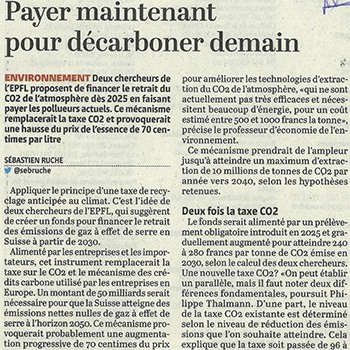
The Swiss Negative Emissions Fund, entirely paid for by polluters, can significantly accelerate Swiss decarbonization and efficiently remove limited remaining emissions
Imagine you are operating a paint factory, and while you make some effort not to pollute too much, toxic chemicals continue accumulating in the ground. At some point you’ll have to stop polluting completely and clean up, either because the law could change, or neighbors could get upset, or even worse, people could start dying. The cleanup is difficult and expensive, and will only work if you stop further pollution. The cleanup methods and technology are not yet perfect and will improve, but only if someone is using them and learning from experience. But why you? This could reduce your profits, so you hesitate. Unless your competitors do the same, it will be hard for you to compete. Also, shouldn’t the commune, which benefited from the taxes you paid for years, contribute to the cleanup?
How can this reflection help us think about reaching net zero?
There are several key differences: CO2 is dangerous only in high concentrations or through climate change, the problem is global, CO2 removal is rarely permanent and could be reversed, all large-scale carbon removal projects usually have bad side effects unless specifically designed for co-benefits, and fossil fuels are at the core of every aspect of today’s society.
Yet all main aspects of our story apply entirely to net zero. Cleanup will only work if we stop polluting. It is expensive now and costs will fall, but only if we start de-polluting now; waiting will not help. For fairness and to create the right incentive, polluters should pay, not the whole community. All competitors should have to do the same, via a border adjustment payment if abroad.
In our paper “Swiss Negative Emissions Fund – paying for Net Zero” we propose a public fund, starting in 2025 and reaching full scale in 2030. The compulsory payment by all Swiss emitters of greenhouse gases would be used to remove CO2 via biological and geological projects. Such projects would engage local communities and create jobs, while restoring ecosystems, improving biodiversity, regenerating soils and improving food resilience. The resulting carbon price would create an incentive to reduce emissions faster and deeper, by 90% in 2045, and make removals possible.
Results: we reach Swiss net zero, when annual carbon removals exceed remaining deeply reduced emissions, around 2040, a full decade faster than the official commitment, and gradually remove all greenhouse gases emitted from 2030 on. Importantly, Switzerland would respect IPCC’s 1.5°C carbon budget.
We started our blog with “imagine”. Paraphrasing Elinor Ostrom when speaking about Garrett Hardin’s commons, does this mean we just made it all up? Where’s the data?
Our results come from a numerical model (computer program) we built based on costs and potentials of different carbon removal methods, as well as a financial analysis of cash flows in and out of the fund. To test, refine and validate all the assumptions we made, we also propose a pilot fund, starting in 2022, on a voluntary basis, at about 1% of the size of the full fund.
The experience with the pilot fund would validate the approach in real life and build acceptance.
What do you think? Please write and let us know.

